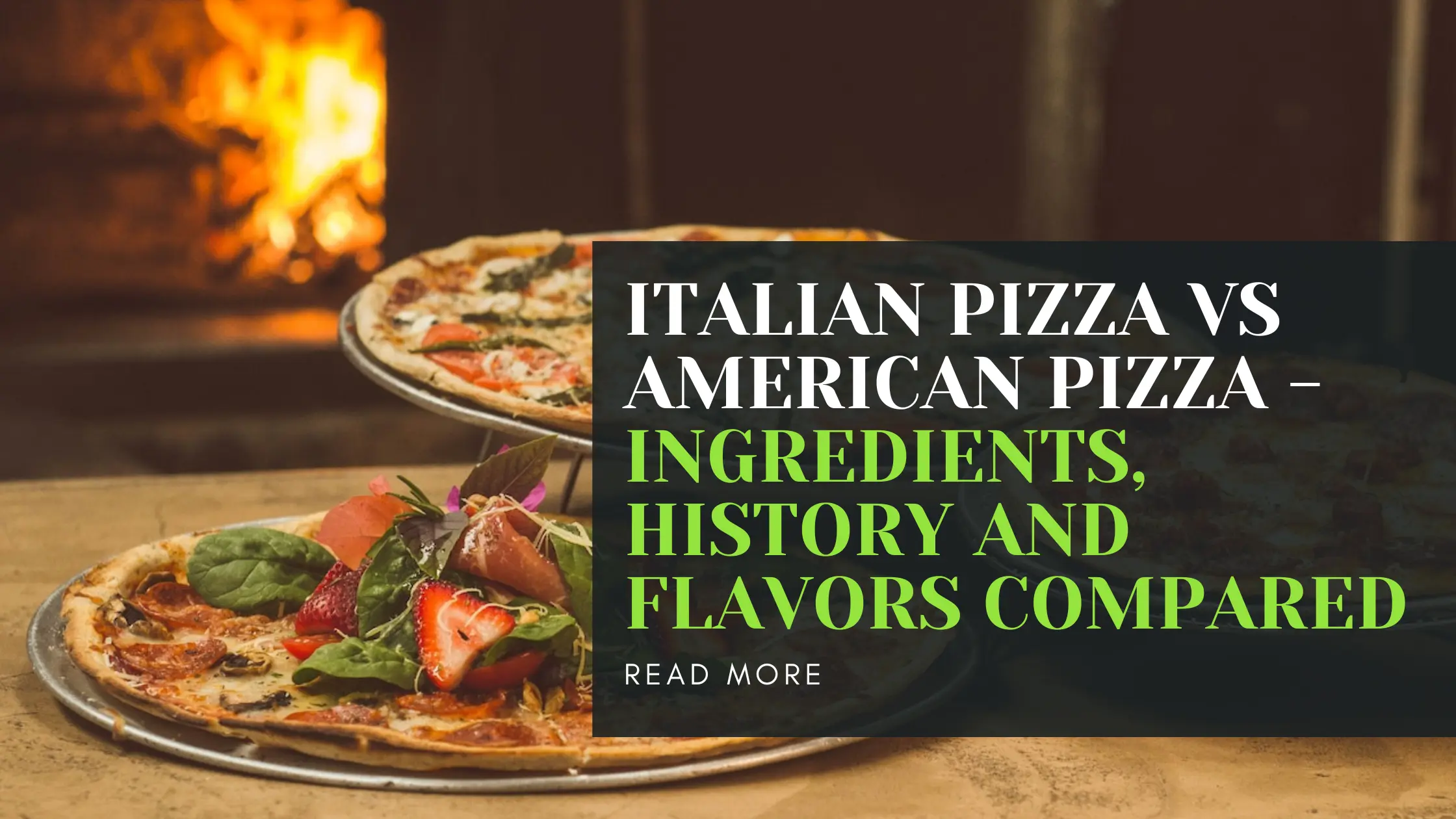Pizza is one of the most popular foods around the world. But not all pizzas are created equal. There are distinct differences between Italian pizza vs American pizza in terms of ingredients, cooking methods, textures, crusts, sauces, cheeses, toppings, tastes, eating styles, nutrition, and costs.
This article provides a comprehensive comparison of Italian vs American pizza so you can decide which version you prefer.
Key Differences Between Italian Pizza vs American Pizza
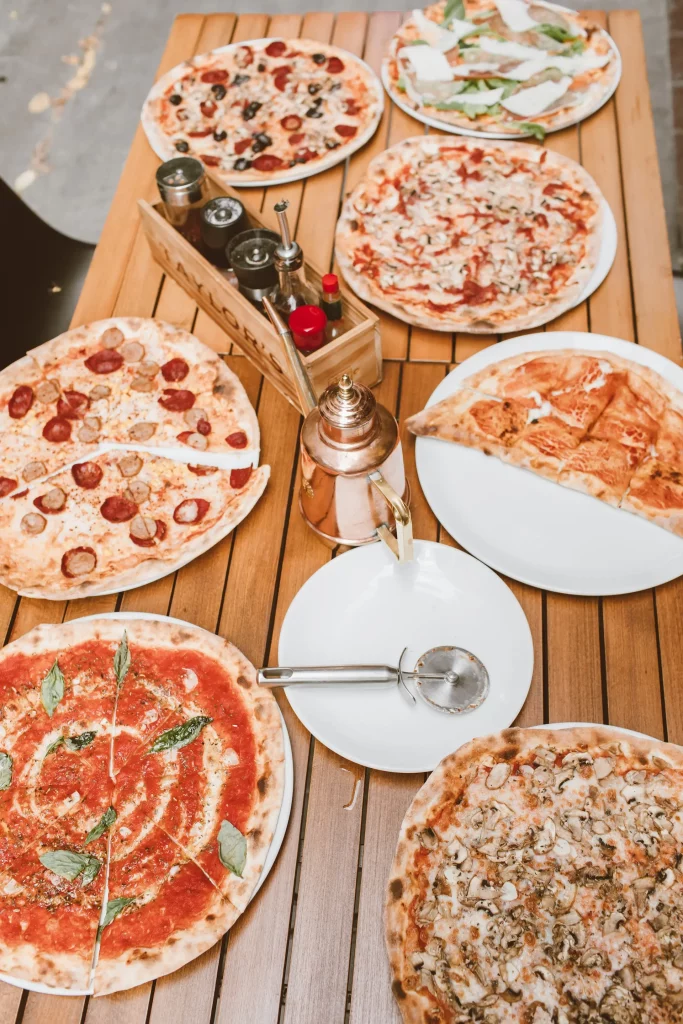
Here is an overview of the main differences between authentic Italian pizza and American pizza:
- Ingredients – Italian pizza uses minimal ingredients like tomato sauce, mozzarella and olive oil, while American pizza includes many complex toppings.
- Cooking Method – Italian pizza is baked in a wood-fired oven at over 800°F and American pizza bakes at 400-500°F in a regular oven.
- Texture – Italian pizza has a thin, crispy, airy crust. American pizza tends to be thicker and chewier.
- Crust – Italian pizza crust is very thin. American pizza crust ranges from thin to thick.
- Sauce – Italian pizza uses a simple crushed tomato sauce. American pizza uses complex, tangy tomato sauce.
- Cheese – Italian pizza uses mozzarella. American pizza uses mozzarella plus cheddar, provolone, etc.
- Toppings – Italian pizza uses minimal toppings like mushrooms, anchovies, etc. American pizza piles on many toppings.
- Taste – Italian pizza has a subtle, light taste. American pizza is more robust and heavy.
- Eating Style – Italian pizza is eaten with a fork and knife. American pizza is picked up and eaten by hand.
- Nutrition – Italian pizza tends to be lower in calories and fat than American pizza.
- Cost – Italian pizza costs more due to specialized ingredients and cooking methods.
Let’s explore each of these differences in more detail.
Ingredients
Italian pizza uses high-quality ingredients but limits the number of toppings. Traditional Neapolitan pizza has just tomato sauce, fresh mozzarella cheese, fresh basil leaves, olive oil, and sometimes anchovies.
American pizza piles on a huge variety of ingredients like different meats, vegetables, and cheeses. A meat lover’s pizza may have pepperoni, Italian sausage, bacon, ham, ground beef, etc.
While Italian pizza sticks to tradition, American pizza satisfies the diverse tastes of the United States by offering tons of options.
Cooking Methods
Authentic Italian pizza is baked in a wood-fired brick oven called a pizza oven. The oven reaches temperatures over 800°F. At this high heat, the pizza cooks rapidly – in just 1-3 minutes.
This quick, high-heat baking gives the crust a charred exterior with an airy interior. The mozzarella gets melted but does not burn or separate.
American pizza is baked in a regular kitchen oven between 400-500°F. The slower baking gives the crust a chewier consistency and the cheese becomes stringier.
Texture
Due to the high-heat wood ovens, Italian pizza has an extremely thin and brittle crust. It has just enough structure to hold the minimal toppings before crisping up in the oven.
The oven’s high temperature and the pizza’s thin profile create an airy interior crumb. This gives the crust a light, crispy texture almost like a cracker or flatbread.
Conversely, American pizza cooked in lower heat has a thicker, chewier crust that can support heavy layers of toppings. Rather than an airy interior, the crust becomes flaky and tender.
Crust
Authentic Neapolitan pizza crust uses a high-gluten Italian flour called 00 flour. The gluten gives the dough an elastic texture that can be stretched thinly.
In comparison, American pizza uses high-yeast doughs including all-purpose flour or bread flour. More yeast makes the crust rise with a thicker, chewier profile.
Italian pizza crust gets stretched by hand or tossed to an incredibly thin 12-16 inches in diameter. American pizza crust is rolled out with a pin to various thicker profiles based on regional styles.
Sauce
Italian pizza uses a simple marinara sauce made from crushed San Marzano tomatoes, olive oil, garlic, salt, and oregano. The bright red sauce has a fresh tomato flavor.
American pizza typically uses a thick, tangy tomato sauce. The sauce is often slowly cooked for a concentrated flavor with added sugar. Popular brands include Rao’s and Don Pepino.
The Italian sauce is light enough to absorb into the thin crust, while the American sauce sits heavily on top.
Cheese
Italian pizza uses soft, fresh mozzarella called fior di latte. The moist cheese adds milky flavor but melts very subtly.
American pizzas often use low-moisture shredded mozzarella. The aged cheese has a tangy, salty flavor and becomes intensely gooey when melted.
American pies also incorporate many other cheeses like cheddar, Monterey Jack, provolone, and Parmesan. Some cheeses get mixed into the sauce as well.
Toppings
Italian pizzas like Margherita include minimal toppings, with less than 3-4 ingredients beyond the sauce and cheese. Common toppings are anchovies, mushrooms, artichokes, prosciutto, etc.
American pizzas pile on the toppings in every combination imaginable. Popular proteins are pepperoni, Italian sausage, bacon, ground beef, chicken, and ham. Veggie toppings include onions, bell peppers, black olives, jalapeños, etc.
While Italians prefer just a few complementary toppings, Americans love intense ingredient combinations on their pies.
Taste
The simple ingredients and quick baking create a lighter, more subtle flavor in Italian pizza. You can taste the essence of the crust, tomatoes, and mozzarella.
American pizzas baked longer with more bold ingredients like pepperoni and tangy cheese have a more intense, greasy, loaded flavor. The interplay of multiple toppings comes through.
Italians prefer the purity of simple flavors, while Americans want a huge variety of intense tastes in each bite.
Eating Style
Italian pizza is usually eaten sitting down at a table using a knife and fork. The thin crust can’t support heavy handling. Neapolitan pizzas are wider and served whole for sharing.
American pizza is picked up with hands and eaten on-the-go. The thicker crust and cut slices allow for easy grabbing and biting. Sicilian pizza gets cut into square slices.
Nutrition
Due to less cheese and toppings, Italian pizza is lower in calories, fat, carbs, and sodium compared to American pizza.
For example, one slice of plain Neapolitan margherita pizza has around 250 calories, 7 grams of fat, and 400 mg of sodium.
An American cheese pizza slice often has 300-400 calories, 15 grams of fat, and 700+ mg of sodium. The abundant meat and cheese toppings increase calories.
So Italian pizza is a lighter meal nutritionally. American pizza is more of an indulgence.
Cost
Authentic Italian pizza costs more to make requiring specialty ingredients and high-temperature pizza ovens.
American pizza is cheaper to make with easy accessibility to ingredients and standard kitchen equipment.
An Italian pizza restaurant will charge $12-15 for a basic Margherita pizza. You can get a full American pepperoni pizza for $5-10 at many chains.
So Italian pizza comes at a premium price point compared to low-cost American pizza options.
The Impact of Commercialization
Pizza has become heavily commercialized, especially American pizza. International chains like Pizza Hut, Domino’s, and Papa John’s have made pizza delivery incredibly convenient and affordable across the United States.
As a result, many of the traditional methods and flavors of Italian and American pizza have been lost or standardized by mega-pizza corporations. Local pizza shops still retain more authentic techniques.
It’s much harder to find high-quality Neapolitan pizza than it used to be in America. Most consumers gravitate towards convenient, cheap pizza from huge franchises.
On the positive side, commercialization has made pizza extremely accessible to Americans. But it has stifled pizza creativity and quality.
Why American Pizza Became More Popular
There are several key reasons why American-style pizza has dominated over Italian pizza:
- Wider appeal – American pizza offers many toppings to satisfy more tastes. Italian pizza is too simple for some.
- Thick crust – More Americans prefer a chewy crust that can hold toppings vs. a thin crispy crust.
- No utensils – American pizza is convenient to eat on the go without a fork and knife.
- Delivery – American chains made pizza delivery popular and affordable.
- Lower cost – Cheaper ingredients and preparation make American pizza cheaper.
- Familiarity – Most Americans are simply more used to American pizza flavors.
- Marketing – American pizza chains are massive multinational corporations with huge advertising budgets.
Overall, American-style pizza is able to please more people with diverse preferences. Italian pizza remains a niche.
How to Make Italian Pizza at Home
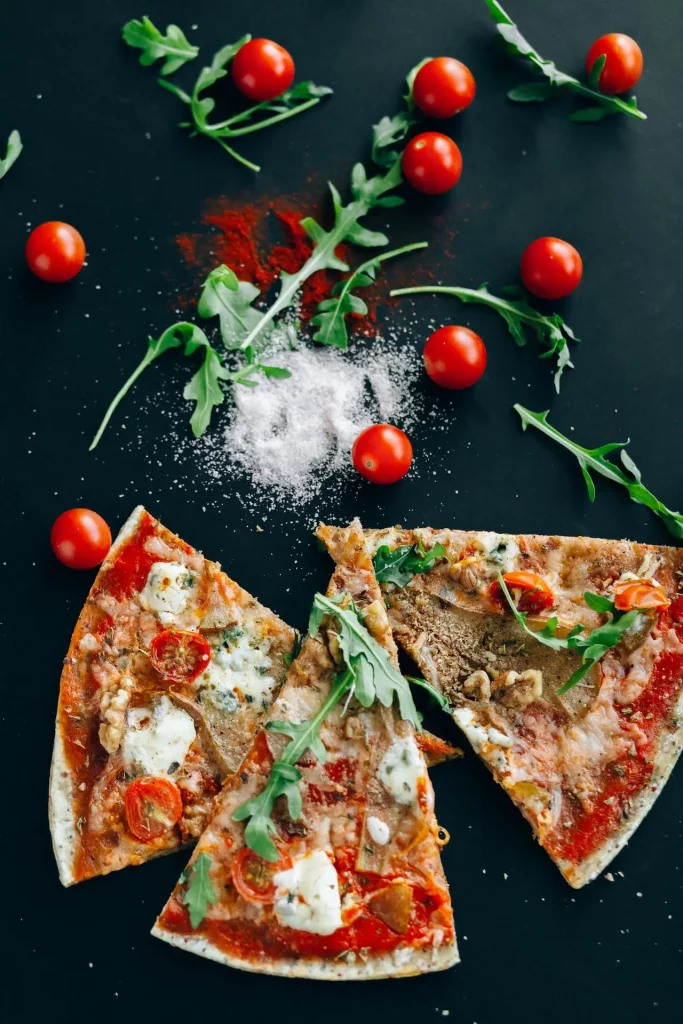
You can recreate delicious Italian pizza at home with these simple steps:
- Make a dough with 00 pizza flour, yeast, salt, and water. Knead thoroughly.
- Let the dough rise for 8-12 hours at room temperature to develop flavor.
- Roll or stretch the dough into a thin 12-16 inch round. Top with sauce, mozzarella, and minimal toppings.
- Bake the pizza at the highest temperature your oven allows for 5-8 minutes until the crust and cheese fully cook.
- Finish with olive oil, basil, oregano, and grated parmesan if desired.
Getting the dough thin without tearing takes practice. A pizza stone can mimic a brick oven. Choose high-quality ingredients for an authentic Italian flavor.
How to Make American Pizza at Home
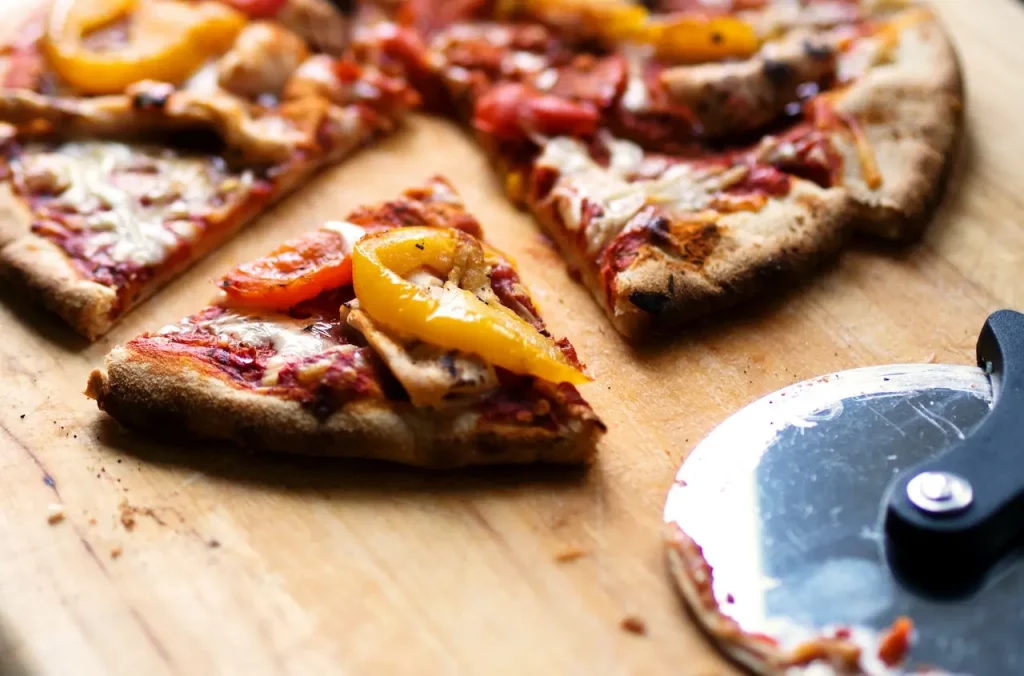
Making American-style pizza at home is also easy:
- Make a dough with all-purpose or bread flour, yeast, vegetable oil, sugar, salt, and water. Knead well.
- Let the dough rise for 1-2 hours at room temperature. Punch it down to release gasses.
- Roll or stretch the dough to your desired thickness, anywhere from thin to deep-dish. Par-bake thick crusts.
- Top with tomato sauce, mozzarella, plus any combination of meats, veggies, and cheeses you want!
- Bake at 450°F for 10-15 minutes based on thickness. The cheese should be fully melted.
- Finish with any extra seasonings like Italian seasoning, crushed red pepper, or oregano.
You can easily satisfy any cravings with homemade American pizza. Experiment with fun regional styles too.
Which Pizza is Better?
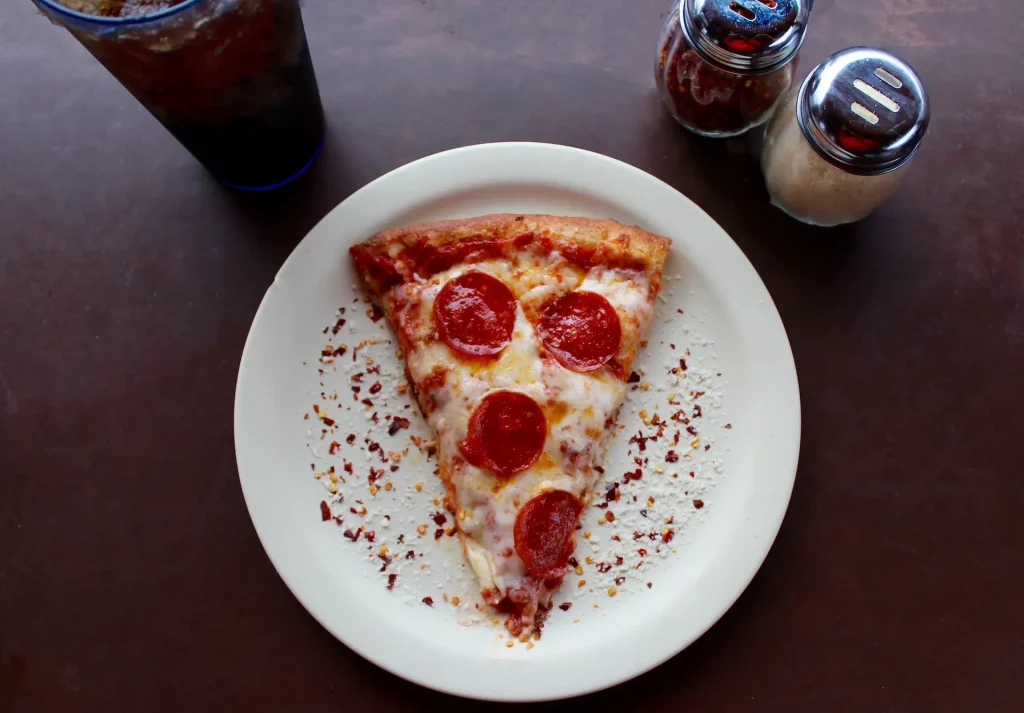
The verdict between Italian vs American pizza depends entirely on your taste preferences:
Go Italian if you want:
- Thin, crispy crust
- Subtle, delicate flavor
- Fresh, high-quality ingredients
- Traditional experience
Go American if you want:
- Thicker, chewier crust
- Bold, intense flavors
- Piled-high toppings
- Customizable experience
There’s no right or wrong! Try both styles fresh to decide which you truly enjoy more.
Many people also love both – you don’t have to limit yourself to just one pizza!
Popular Italian Pizzas to Try
When tasting authentic Italian pizza, go for these traditional staples:
- Margherita – Tomato sauce, mozzarella, basil
- Marinara – Tomato sauce, oregano, garlic, olive oil
- Quattro Formaggi – Mozzarella, gorgonzola, taleggio, parmesan
- Funghi – Mushrooms, olive oil, garlic, oregano
- Diavola – Spicy salami, black olives, dried chili flakes
- Capricciosa – Mushrooms, prosciutto, olives, artichokes
Popular American Pizzas to Try
Get the full American pizza experience with these best-selling pies:
- Pepperoni – Pepperoni, mozzarella
- Supreme – Pepperoni, Italian sausage, mushrooms, green peppers, onions
- Meat Lover’s – Pepperoni, Italian sausage, bacon, ham, ground beef
- Hawaiian – Ham, pineapple
- Veggie – Mushrooms, tomatoes, spinach, bell peppers, onions
- BBQ Chicken – Grilled chicken, red onions, BBQ sauce
Conclusion
While Italian and American pizzas appear similar, they have pronounced differences when it comes to ingredients, crusts, preparation methods, tastes, nutrition, and more.
Italian Neapolitan pizza uses minimal ingredients like crushed tomatoes and fresh mozzarella baked quickly in 900°F wood-fired ovens. The result is a thin, brittle crust with light tomatoey flavor.
American pizza utilizes way more toppings and complex sauces. It gets baked at lower temps in standard ovens producing a more sturdy, chewy crust that can handle heavier toppings.
So choose your pizza style based on your priorities – tradition or customization, light or heavy, subtle or bold flavors. There’s a perfect pie waiting for you whether you go Italian or American!
Frequently Asked Questions
Is New York pizza different from Italian pizza?
Yes, New York pizza differs significantly from Italian pizza in terms of crust and ingredients. New York pizza has a thin to medium-thick crust that is crispy yet chewy. Italian pizza crust is wafer-thin and airy in texture. Toppings are also heavier on New York pizza versus the simplicity of Italian pies.
How is authentic Italian pizza different?
Genuine Italian pizza uses specific ingredients like 00 flour and San Marzano tomatoes, along with high-heat wood ovens above 800°F. This creates a super thin and delicate crust with light tomato flavor and slightly melted mozzarella. Many American pizzas lack these specialized methods and ingredients.
Is pizza Americanized Italian food?
Yes, pizza in America has drifted away from its Italian roots with the popularity of chains like Pizza Hut, Dominos, and Papa Johns. American-style pizza uses different ingredients and has more cheese and toppings versus traditional Italian pizza.
Why is American pizza better than Italian?
American pizza is more popular due to its thicker crust, abundant cheese, many diverse toppings, and convenience of delivery. More Americans prefer these attributes over the thinner, lighter crust and minimalist toppings of Italian pizza. However, Italian pizza is arguable more authentic.
Why is Italian pizza so popular?
Italian pizza is beloved for its thin, crispy crust baked in extremely high-heat ovens. The fresh, high-quality ingredients like San Marzano tomatoes and mozzarella also create a delicious subtle flavor. The tradition and superiority of Italian pizza make it popular globally.
Who invented pizza America or Italy?
Pizza originated in Italy during the 18th or 19th century in Naples. Italian immigrants then brought pizza recipes over to America in the early 1900s. While pizza has evolved significantly in the US, its roots trace back to traditional Italian pies.
What pizza do Italians prefer?
Italians overwhelmingly prefer thin crust Neapolitan-style pizza with minimal ingredients like Margherita with tomato sauce, mozzarella, and basil. Thick-crust American pizza loaded with meats and cheeses is less popular in Italy.
What is America’s most loved pizza?
Pepperoni pizza is consistently ranked as America’s #1 favorite pizza topping. Over 36% of Americans say pepperoni is their go-to pizza order. Pepperoni pizza combines salty and spicy flavor with the hearty meat that Americans love.
Is Italian pizza healthier than American pizza?
Yes, Italian pizza tends to be lower in calories, carbohydrates, fat, and sodium compared to American pizza. Italian pizza uses less cheese and toppings than the overloaded American versions, making it a marginally healthier choice.
Why is Italian pizza so much better?
Italian pizza is made with superior ingredients like 00 flour and San Marzano tomatoes. It gets baked at 800-900°F in wood-fired ovens that few American pizzerias use. This produces a thin crust with subtle sweet tomato flavor and creamy mozzarella that many consider far tastier than American pizza. The tradition and mastery of Italian pizza-making lead to its excellence.
Read more:https://worldvisitguider.com/pizzo-italy/

